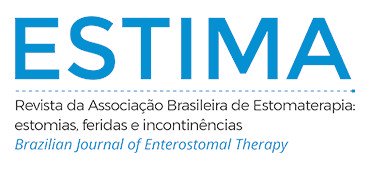Profile analysis and hospitalization outcomes in critically ill patients with pressure ulcers
Abstract
Objective: To describe the clinical profile of patients who developed pressure ulcers (PU) during intensive care in a cardiology unit and to identify the factors associated with discharge and death outcomes. Method: Observational, retrospective cohort study. Patients who developed PU during their stay in the intensive care units (ICUs) of a philanthropic hospital in São Paulo and were recorded in the database from January 2018 to June 2020 were included. The study was approved by the institution’s Research Ethics Committee. Fisher’s Exact Test, Student’s t-test, and Pearson’s ꭓ2 test were used to assess the associations, with a significance level of 0.05. Results: Among 456 critically ill patients evaluated, 51 developed PU in the ICU, with a prevalence of 11%. The sample consisted of 84.3% male patients, with a mean age of 75.8 years (SD=13.6). Sacral PU were present in 70.5% of the cases. Nutritional risk, SAPS 3 score, length of ICU stays, capillary refill time, age, and RASS score showed significant correlations with death as an outcome. Conclusion: Clinical factors correlated with death outcomes were identified in critically ill patients who developed PU in the ICU. As a clinical implication, the findings highlight the importance of guiding care teams to implement targeted care strategies for these patients.
Downloads
Metrics
References
European Pressure Ulcer Adivisory, National Pressure Injury Adivisory Panel and Pan Pacific Pressure Injury Alliance. Prevention and treatment of pressure ulcers/injuries. prevention and treatment of pressure ulcers/injuries. clinical practice guideline [Internet]. 2019. [acessado 2024 Jun. 21]. Disponível em: https://internationalguideline.com/
Serrano ML, González M´´endez MI, Carrasco Cebollero FM, Lima Rodríguez JS. Risk factors for pressure ulcer development in Intensive Care Units: a systematic review. Med Intensiva. 2017;41(6):339-46. https://doi.org/10.1016/j.medin.2016.09.003
Adibelli S, Korkmaz F. Pressure injury risk assessment in intensive care units: comparison of the reliability and predictive validity of the Braden and Jackson/Cubbin scales. J Clin Nurs. 2019;28(23-24):4595-605. https://doi.org/10.1111/jocn.15054
Barreto RMS, Santos RLN, Melo EMVB. Profile of people with pressure injuries admitted to the intensive care unit. O Mundo da Saúde. 2019;43(4):1030-43. https://doi.org/10.15343/0104-7809.2019430410301043
Soodmand M, Moghadamnia MT, Aghaei I, Ghasemzadeh G, Lili EK, Rad EH. Effects of hemodynamic factors and oxygenation on the incidence of pressure ulcers in the ICU. Adv Skin Wound Care. 2019;47(6):359-64. https://doi.org/10.1097/01.ASW.0000553599.20444.f4
El-Marsi J, Zein-El-Dine S, Zein B, Doumit R, Badr LK. Predictors of pressure injuries in a critical care unit in Lebanon: prevalence, characteristics, and associated factors. J Wound Ostomy Continence Nurs. 2018;45(2):131-6. https://doi.org/10.1097/WON.0000000000000415
Brasil. Agência Nacaional de Vigilância Sanitária. Nota técnica GVIMS/GGTES no 03/2017. Práticas seguras para prevenção de lesão por pressão em serviços de saúde [Internet]. 2017 [acessado 2024 Ago. 21]. Disponível em: https://www.gov.br/anvisa/pt-br/centraisdeconteudo/publicacoes/servicosdesaude/notas-tecnicas/notas-tecnicas-vigentes/nota-tecnica-gvims-ggtes-no-03-2017.pdf
Cavalcante MLSN, Borges CL, Moura AMFTM, Carvalho REFL. Indicators of health and safety among institutionalized older adults. Rev Esc Enferm USP. 2016;50(4):602-9. https://doi.org/10.1590/S0080-623420160000500009
Chung ML, Widdel M, Kirchhoff J, Sellin J, Jelali M, Geiser F, et al. Risk factors for pressure injuries in adult patients: a narrative synthesis. Int J Environ Res Public Health. 2022;19(2):761. https://doi.org/10.3390/ijerph19020761
Assis IIC, Santos JE, Abib MLVS, Bueno LF, Coelho MMF, Cortez DN, et al. Medical device-related pressure injury in an intensive care unit: a cross-sectional study. Wound Manag Prev. 2021;67(11):26-32. PMID: 35030095.
Pachá HHP, Faria JIL, Oliveira KA, Beccaria LM. Lesão por pressão em unidade de terapia intensiva: estudo de caso-controle. Rev Bras Enferm. 2018;71(6):3203-10. https://doi.org/10.1590/0034-7167-2017-0950
Oliveira BA, Zanchetta FC, Barbieri B, Falcioni CAS, Araújo EP, Lima MHM. Point prevalence and risk factors for pressure ulcers in hospitalized adult patients: a cross-sectional study. Einstein (Sao Paulo). 2024;22:eAO0811. https://doi.org/10.31744/einstein_journal/2024AO0811
Assis SF, Vieira DFVB, Sousa FREG, Pinheiro CEO, Prado PR. Adverse events in critically ill patients: a cross-sectional study. Rev Esc Enferm USP. 2022;56:e20210481. https://doi.org/10.1590/1980-220X-REEUSP-2021-0481en
Rodrigues JM, Gregório KC, Westin UM, Garbuio D. Incidência e fatores relacionados ao aparecimento de lesões por pressão em unidade de terapia intensiva. ESTIMA, Braz J Entrostomal Ther. 2021;19:e1121. https://doi.org/10.30886/estima.v19.1014_PT
Ayello EA, Levine JM, Langemo D, Kennedy-Evans KL, Brennan MR, Gary Sibbald R. Reexamining the literature on terminal ulcers, SCALE, skin failure, and unavoidable pressure injuries. Adv Skin Wound Care. 2019;32(3):109-21. https://doi.org/10.1097/01.ASW.0000553112.55505.5f
Kim JH, Shin HK, Jung GY, Lee DL. A case of acute skin failure misdiagnosed as a pressure ulcer, leading to a legal dispute. Arch Plast Surg. 2019;46(1):75-8. https://doi.org/10.5999/aps.2018.00087
Sasabe Y, Niitani M, Teramoto C, Yamaga S, Shime N, Tanabe K, et al. Deep sedation predicts pressure injury in patients admitted to intensive care units. Nurs Crit Care. 2022;27(6):877-84. https://doi.org/10.1111/nicc.12753
Labeau SO, Afonso E, Benbenishty J, Blackwood B, Boulanger C, Brett SJ, et al. Prevalence, associated factors and outcomes of pressure injuries in adult intensive care unit patients: the DecubICUs study. Intensive Care Med. 2021;47(2):160-9. https://doi.org/10.1007/s00134-020-06234-9
Munoz ND, Posthauer ME, Cereda E, Schols JMGA, Haesler E. The Role of Nutrition for Pressure Injury Prevention and Healing: The 2019 International Clinical Practice Guideline Recommendations. Adv Skin Wound Care. 2020;33(3):123-36. https://doi.org/10.1097/01.ASW.0000653144.90739.ad
Ottaviani S, Rondanina E, Arnone F, Brucato V, Campigli R, Bona MD, et al. Multidimensional-based prediction of pressure ulcers development and severity in hospitalized frail oldest old: a retrospective study. Clin Interv Aging. 2024;19:1509-17. https://doi.org/10.2147/CIA.S440943
Chaboyer WP, Thalib L, Harbeck EL, Coyer FM, Blot S, Bull CF, et al. Incidence and prevalence of pressure injuries in adult intensive care patients: a systematic review and meta-analysis. Crit Care Med. 2018;46(11):e1074-e1081. https://doi.org/10.1097/CCM.0000000000003366
Black JM. Root cause analysis for hospital-acquired pressure injury. J Wound Ostomy Continence Nurs. 2019;46(4):298-304. https://doi.org/10.1097/WON.0000000000000546
Delgado SA. Strategies to avoid the unavoidable: preventing hospital-acquired pressure injury. Am J Crit Care. 2019;28(5):353. https://doi.org/10.4037/ajcc2019590
Pittman J, Beeson T, Dillon J, Yang Z, Mravez M, Malloy C, et al. Hospital-acquired pressure injuries and acute skin failure in critical care: a case-control study. J Wound Ostomy Continence Nurs. 2021;48(1):20-30. https://doi.org/10.1097/WON.0000000000000734
Downloads
Published
How to Cite
Issue
Section
License
Copyright (c) 2025 Isabela Gomes Musa dos Santos, Beatriz Santana Prado , Henrique Mateus Fernandes , Natalia Balestra , Karoline Razimavicius Barbado , Aline de Oliveira Ramalho

This work is licensed under a Creative Commons Attribution 4.0 International License.

























